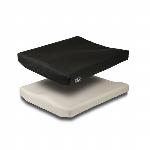SpinLife Guide to Seat Cushions
When many wheelchair users think of a seat cushion, comfort comes to mind.
When many wheelchair users think of a seat cushion, comfort comes to mind. However, a seat cushion provides benefits well beyond comfort, including pressure management and positioning that can reduce fatigue and enhance seated balance throughout the day. Surely, not everyone’s positioning and sense of comfort is the same, so understanding cushion technologies is key to selecting the right cushion for you.
Seat Cushions are designed to offer:
- Comfort
- Pressure management
- Positioning
- Increased sitting stability
Indeed, there are many wheelchair cushions available - including foam, gel, and air technologies - and in understanding the benefits and limitations of each one, you can decide which is best for you.
Cushion Varieties
Other Cushion Resources
Foam Cushions
Foam cushions are the most basic cushion, ideal for those wishing simplicity at minimal cost. While some foam cushions are a single-density (firmness), others feature contoured bases with multiple layers of foam, designed for enhance pressure management and positioning.
A foam cushion may be best for you if you need:
- Low maintenance
- Minimal cost
- A very stable seating surface
- Low to mid-range positioning
- Light weight
A foam cushion may not be best for you if you need:
- Exceptional pressure relief
- Advanced positioning characteristics
Gel Cushions
Gel cushions are specifically designed to optimize pressure relief by allowing one’s pressure points to "immerse" into a gel pack, reducing pressure. Additionally, gel cushions typically feature a contoured base, with advanced positioning characteristics.
A gel cushion may be best for you if you need:
- Optimal pressure relief
- Advanced positioning
- A very stable seating surface
- Low maintenance
A gel cushion may not be best for you if you need:
- Light weight
- Low cost
Air Cushions
As the name suggests, air cushions are filled with air, and by adjusting the air pressure, the cushion’s firmness can be adjusted. Air cushions typically offer reduced stability and positioning by comparison to foam and gel cushions, but are exceptional in the area of pressure relief, allowing pressure points to "sink" into the cushion. Air cushions are commonly available in 2" and 4" heights, with the 2" offering a low-profile, more stable surface, and the 4" offering maximum pressure relief.
An air cushion may be best for you if you need:
- Exceptional pressure relief
- Adjustable firmness
- Light weight
- Low maintenance
An air cushion may not be best for you if you need:
- Low maintenance (air cushions require regular monitoring of air pressure, and can develop leaks)
- Advanced positioning characteristics
- Utmost seating surface stability
- Low cost
Selecting & Maintaining a Cushion
- A seat cushion’s size should be matched exactly to the wheelchair’s seat size
- Remember that a seat cushion’s height adds to the wheelchair’s seat-to-floor height, so a taller cushion will cause you to sit taller, accordingly (which can be an issue fitting under tables and desks)
- If there’s a chance that the cushion will be exposed to fluids, an incontinence cover should be used (incontinence covers come included with many cushions)
- Inspect the cushion regularly for degraded materials or damaged foam
- With air cushions, confirm proper inflation daily
- Most cushions have an optimal use life span of two to three years, so for proper performance, replace a cushion when needed
By Mark E. Smith





 Contact Us
Contact Us
 M-F 9am - 6pm ET
M-F 9am - 6pm ET
 Request parts
Request parts Request Service
Request Service


